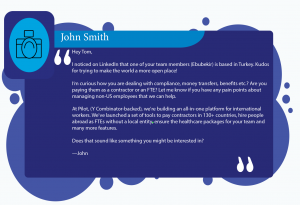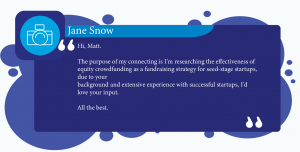Social selling means connecting, interacting, and creating relationships with prospects and customers on social platforms. It all circles around sharing company-suitable content, gaining credibility, and providing value to your targeted audience. Sounds simple, right?
Well, not so much. Many companies are doing it wrong. Just lurking on social media for another sale pitch or another deal you can close, is not considered successful social selling. Exploiting social platforms for sales purposes is more harmful than beneficial. The name ‘social selling’ makes people think they can jump right away into sales, although the real intention should be having intellectual conversations. This article explains good and bad social selling techniques and underlines the differences.
Spam mails
Social selling became so frequent and overused that Linkedin inboxes are spammed with sales emails. At first glance, they seem personalized, but when taking a closer look, prospects realize that it’s just another sales pitch. Most of the time, it starts with a simple introduction resulting in a solicitation for their time or to buy a product or service. Those messages are automated and far from being personalized. If one thinks that automated emails will start fruitful and genuine conversations, then the potential customers are dramatically underestimated. Prospects that are already exposed to those spam emails end up ignoring or not responding as they represent a superficial way to connect and sell.
Odd interactions
Another bad, but common practice within social selling, are creepy interactions with salespeople. Customers indeed expect sales reps to know their profile already, but only to a certain extent. Imagine that you get a new neighbor. The second time you two accidentally run into each other, he calls you by your nickname and asks you about your recent trip to New York. Wouldn’t that be a bit creepy?
That’s exactly how customers feel if sales reps do their homework, but bring it up in the wrong way. Here is a real example, where the research was good, but the way of addressing is too straightforward. It is highly unlikely that people want to give sensitive information to strangers. So you’re advised not to ask for it as it appears intruding (see example below).

The importance is to bring up the researched information in a thoughtful way. The line between well-done research set to a fruitful or a creepy interaction is thin. In social selling, we can observe the same phenomenon: Sales reps should be informed and know what their buyers need, but they shouldn’t make them feel trapped or stalked.
Connect with caution
Social networks can only be commercialized to the fullest if companies have an audience and reach potential customers. But this isn’t an excuse to randomly connect with everyone. Bear in mind that sending requests to connect with prospects you’ve never even spoken to can be harmful. LinkedIn needs a well-considered approach, whereas Twitter is a more casual platform where you can follow potential customers down to your whim. The ground rule says: Do not follow prospects unless you’ve had a meaningful interaction with them. Exceptions must contain a highly personalized message, and the connection should lead to intellectual conversations and exchange. Here is a good real-life example of how you can connect with people.
She did her homework and addressed it in a gentle way. Moreover, she is not trying to sell anything, but asking for input and experience. Our subject approved her request, she followed up with this:

She nailed it: people want to connect and share their experiences and insights. They like to talk about themselves, their successes, and what interests them. Furthermore, expanding one’s network can create mutual relationships and help one day.
Social selling is a trustworthy relationship
Social selling used in earnest, can be a real differentiator for your company and help you reap true sales opportunities. Nevertheless, it’s not something for companies without resilience because it is time-consuming and a long-run strategy. If you want to have a competitive advantage, then you have to start doing it right. Build up trust by providing mutual connections and intellectual exchange. A good and straightforward way to raise confidence is by helping prospects instead of selling. Showing goodwill is key to a trustworthy relationship, which will resonate in sales opportunities.
“Social selling is comparable to a bank – you are making deposits, and one day you will withdraw.” Tom Alaimo, Sales Manager at TechTarget
Another way of building trust is to share success stories or a testimonial. Even though everything is online, you should never underestimate the power of word of mouth. It might come in different shapes, but having a recommendation from other buyers is still golden. Business buyers want to know their vendors and care about their reputation and recommendations.
Conclusion
Companies claim to do social selling, but they jump right into selling their product or services. They seem to ignore the great ways of using social selling tools and, therefore, missing out on sales opportunities. The technique itself is not obsolete; it just needs time to nurture from the content and the connections. If you are willing to play the long game and succeed in the end, rethink your strategy: Build up a strong brand image, which can be trusted and connect with consideration. Invest time to help your prospects and highly personalize your interactions without being creepy.
Here at Enki, we can help you to find the right background information to start interactions. Our AI-based software solution offers market trends and insights, which could be valuable content to share
Want to learn more? Get in touch with us.


